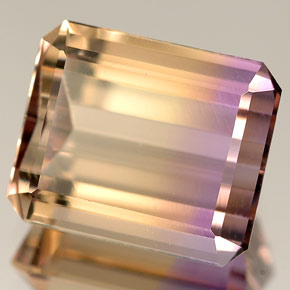The Gemstone Ametrine

Ametrine is a relatively new gem term, and the word is a combination of Amethyst and Citrine. Ametrine is a unique gemstone in that it is essentially combined of two separate gemstones. Although Amethyst, the purple variety of Quartz, and Citrine, the yellow/orange variety of Quartz belong to the same scientific mineral classification, they have always been distinguished as individual gemstones. The unique color combination of Ametrine has sparked an interest and appeal to this distinctive gemstone.
Color
?
Yellow, Purple, Multicolored
Additional Properties
|
Refractive Index
?
1.54 - 1.55 |
Double Refraction
?
.009 |
Transparency
?
Transparent |
SG
?
2.63 - 2.65 |
Luster
?
Vitreous |
| Cleavage ?
Indiscernible |
All About
The only significant source of Ametrine is the Anahí Mine in Bolivia. The mine is operated by Minerales y Metales del Oriente. This mine is for all practical purposes the only source of Ametrine available in the gem trade. Although this gemstone deposit has been known to the natives for several hundred years, it is only since the 1980's that it has been worked on a commercial level. In the early days of commercial production of this mine, the locality was a bit obscured and dealers were frequently selling the gems with localities such as Brazil and Uruguay. Although Ametrine is known to have been found naturally in a few other South American Amethyst deposits, the finds are very sporadic and not economically important.
Each Ametrine has its combination of colors in a different pattern. Ametrine gems are most often cut to product a stone half purple and half golden, although sometimes both colors are present as a mixture or other percentages are used. Sometimes a rounded checkerboard pattern is present on the stone with a clear distinction between the Amethyst and Citrine.
Ametrine can be artificially created by partial
heat treatment of certain Amethyst or by
irradiation. Lab-produced synthetic Ametrine has also been simulated. However, despite Ametrine's rarity in that its occurrence is restricted to one locality, Ametrine is relatively affordable and synthetic forms are not really in demand.
Uses
?
Ametrine is usually faceted in a rectangular cut for jewelry. It is also used for ornate carvings such as animal carvings.
Treatments & Enhancements
?
Ametrine gemstones are natural and not treated or enhanced. Ametrine is sometimes synthesized using the
hydrothermal
method, which often creates colors that are very vivid and are more intensely colored than their natural counterpart.
Ametrine Sources
?
The only significant locality producing this gem is the Anahí Mine (Mina Anahí), which is located in the eastern part of the country near the Brazilian border.
Similar Gemstones
?
The unique color combination of Ametrine distinguishes it from other gemstones.
Ametrine in the Rough Photos
?